chapter
Introduction: Hybrid Culture in a Changing World
Remember 2020? With the Covid pandemic in full swing, cultural organizations were forced to re-evaluate their workflows, business models, and the types of events they organized. How to deal with the temporary breaks in on-site programming along with financial losses? Out of this extreme condition, a new attitude emerged regarding digital exhibition formats, live broadcasting, and the overall online presence of cultural actors. A newer, shinier format loomed at the horizon: the hybrid event.
We’ve seen videolive streams set up on a spacestage, with performancespeakers giving a lecture and no audience except the viewers at home behind their computer; clunky live events with pre-recorded interviews that pixelate with every hesitation of the WiFi; videoInstagram Lives that nobody watches or that everyone is watching; countless videoZoom live streams with break-out rooms and tens of people on audiomute, fighting the Zoom fatigue or their clingy cat. Already in November 2020, Geert Lovink wrote about the phenomenon of Zoom fatigue: Geert Lovink, ‘The Anatomy of Zoom Fatique’, Eurozine, 21 November 2020, https://networkcultures.org/geert/2020/11/21/anatomy-of-zoom-fatigue. And we’ve also seen marvelous experiments: objecta big screen on a spacelive stage that shows a lively, textonline chat which is actually integrated into the conversation; performancea buddy system where an offline visitor takes their online friend by the hand (meaning, on their phone) and guides them through an spaceexhibition, event, Q&A’s with speakers live on stage.
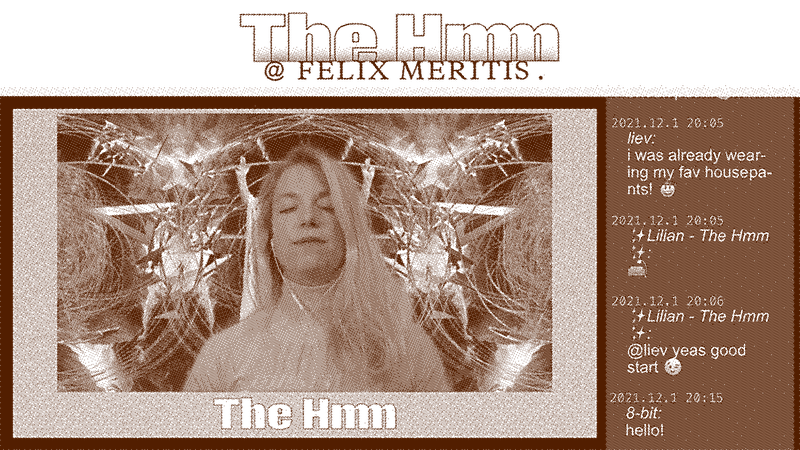
Many exciting, experimental formats were tested by platform for internet culture The Hmm. You can read a report on these experiments in The Hmm’s dossier ‘Hybrid Events’: https://thehmm.nl/the-hybrid-formats-we-tested.
We’ve witnessed performanceTravis Scott playing a concert in the game websiteFortnite, for a whopping 27 million viewers—and he wasn’t the only one. Roel Vergauwen, ‘Will Games Become the New Concert Temples?’, Boekman, https://catalogus.boekman.nl/pub/P21-0355.pdf. Cultural institutions, usually relying on their audience having to travel to an offline destination to attend an event, found that they could reach a bigger and more international audience, and on top of that, speakers didn’t need to travel which saves both time and costs. Also, the common use of videolivestreams and textcaptions created new accessibility features for audience groups with different needs. It became possible to be sick and participate in culture, to be cooking dinner for your children and participate in culture, to have hearing impairments and participate in culture. These needs existed before the pandemic and will exist in the future too. It remains important not to forget the issue of accessibility now that on-site programming is the norm once again.
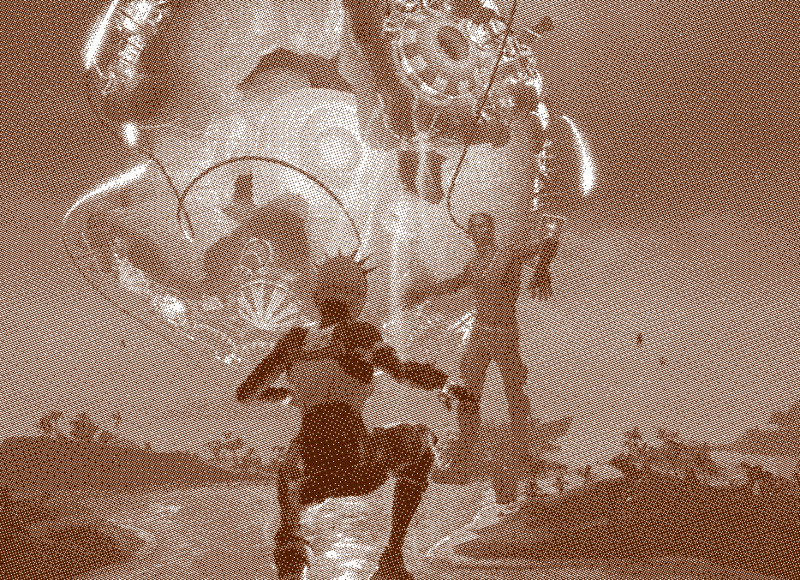
A lockdown concert by Travis Scott in Fortnite with a live audience of 27 million.
These are only some of the many advantages hybrid events can offer, and it doesn’t stop there: hybridity gives way to exciting new experiments in publishing, or the development of ‘living archives’ that share these beautiful hybrid experiments in an interactive, dynamic way. Because of course, a truly fun hybrid event is hard to translate into a videotwo-hour video registration put on YouTube, however much we want to share the experience with the people who couldn’t make it. This, interestingly, is mostly because the hybrid event incorporates a live experience found formerly in the offline event: it has transformed itself into a whole new kind of experience. Two worlds that once seemed so far apart now smoothly (or not so smoothly) collided and merged into new, hybrid constellations.
About the Going Hybrid Research Project
This book brings together the insights from two years of hands-on, state-of the art research in hybrid cultural programs: Going Hybrid. Going Hybrid was supported with a RAAK-Mkb grant from Regieorgaan SIA. You can read more about the project here: https://networkcultures.org/goinghybrid/about. For this project, the Institute of Network cultures partnered up with cultural institutions (Framer Framed, IMPAKT, MU) and self-organizing collectives (Hackers & Designers, The Hmm, Varia members Simon Browne and Artemis Gryllaki) to explore how covid innovations in cultural programming could be turned into durable, culturally valuable formats. Our central question was: How can program providers in the cultural and creative industries connect new and existing audiences to a hybrid, high-quality cultural program in a sustainable and technologically independent manner?
The research consisted of three parts. One was about hybrid events. How to create interesting new forms of hybrid interaction? How do they ensure that both groups have an equal experience at these videolivecasts? And how to give both on-site and online audiences a sense of agency in an event? The other two parts were about what happens after the event: the publication, and ultimately the archiving of the outcomes. How to translate a hybrid cultural experience into something visitors can videowatch, textread, follow afterward? Is it possible to capture the essence, the interactive essence, of a hybrid event and reproduce it? And how do they harness the potential of this recorded material for publication and lasting audience interaction in their websitedigital (web) archive? Three groups, corresponding with the three main questions, set out research (the use of) existing platforms, to gather expertise, and ultimately to develop a prototype tool for hybrid culture.
The events group created Emoji Proxis & Ghost Messengers, a tool for interaction between on-line and on-site audiences, giving online audience direct agency over things that happen in space. For instance, by typing a command in the livestream chat, online audience members can performanceactivate an on-site scentscent objectdispenser, or performancephysically move objectthe camera. A version of this tool was presented during the Going Hybrid conference. Read more about this tool and the workshop here: https://networkcultures.org/goinghybrid/2023/03/29/workshop-emoji-proxies-ghost-messengers-conference-report-day-2.
The publications group developed Etherport: a tool for cultural organisations to make more experimental and exciting. In Etherport, event reports including texttext, videovideo, still imageimage, and audiosound are connected by a web of tags, drawing non-linear connections between different parts of the event report, and between different reports. The tool helps to standardize the event reporting workflow, reducing production workload and clarifying the role division between authors and editors. But, most importantly, it allows for event-reports to connect different levels of knowledge and observations, to create a web of meaning between reports, and thereby – hopefully – to provide a more exciting, explorative reading experience. You can read more about this tool and how to use it in the intermission ‘Introducing Etherport’.
The research of the archives group resulted in MUMORIES, an audioaudio spaceinstallation where visitors are invited to share their memories of cultural institution MU Hybrid Art House. These memories are collected and form a websiteliving digital audio archive that can eventually be listened to on site but also online. The growing collection of MUMORIES made possible by this interface literally gives voice to the immaterial impact a cultural practice like MU’s has on visitors. You can explore and interact with MUMORIES online here: https://mumories.hackersanddesigners.nl/Welcome.
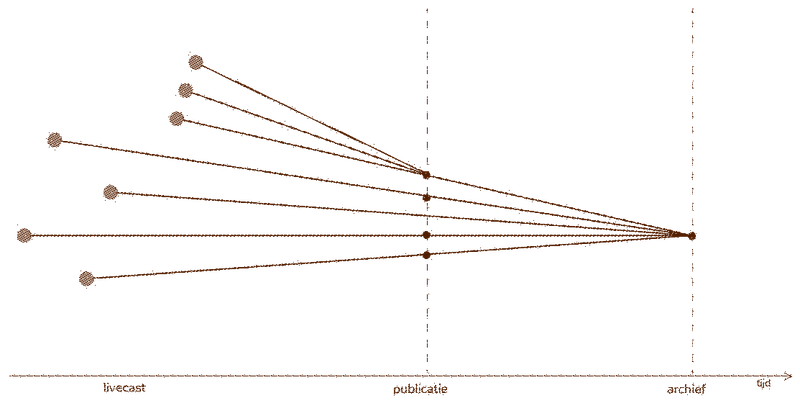
The workflow of multiple hybrid events, converging a few hybrid publications, and, finally, into one living archive. This graph was created in 2020 for the project appplication by Marijn Bril.
We’re proud and happy to put these prototype tools out into the public domain. But they are not three separate experiments. Together, the three parts of Going Hybrid encompass the entire workflow of hybrid cultural programming: via participatory livecasting of events, the coherent reporting of these through publications that eventually enter living archives. This integral approach reflects a broader urgency that was shared between all members of the consortium. We all wanted to go beyond the misery that comes to mind when someone says ‘hybrid meeting’.
Yes, the physical and digital have mixed and merged in hybrid new realities, but we yearned to explore hybridity beyond that: across media and spaces, challenging conceptions of hierarchy, access, time, and voices, that often come with different cultural experiences. How does hybridity shift the reading, writing, and publishing process? How can an archive become alive? And how can an audience interact in hybrid events? It was by confronting the first initial questions with deeper ones that we found meaning in this collective endeavour. We believed that the integral redefinition of hybridity can be the basis for a long-term, shared vision of high-quality hybrid cultural programing that serves new and existing audiences beyond the covid era.
Multiplying Urgencies
Already within the duration of Going Hybrid, our belief in the relevance of new hybrid culture was put to the test, as the ‘beyond Covid’-urgency we anticipated arrived much sooner than we expected. On the 24th of February 2022, Russia launched a full-scale invasion of Ukraine. While many artists, journalists, and researchers fled the country, the desire for a shared cultural life remained, creating the need being together with culture across borders and distances.
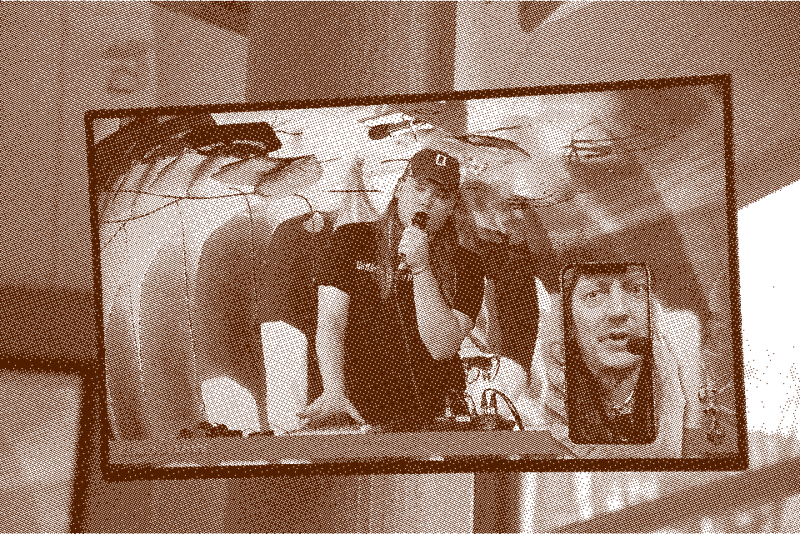
UKRAiNATV contributing to ‘In-between Media: Hybrid Tactics in the Crisis Era’, 9 March 2023 at Spui 25, Amsterdam.
The Institute of Network Cultures set up a Tactical Media Room to give space to underrepresented voices: artists, researchers, and journalists from Ukraine, as well as dissidents from Russia and Belarus. Tactical Media Room can be found on the website of the Institute of Network Cultures: https://networkcultures.org/tactical-media-room. Since then, the Tactical Media Room has developed, and TMR Palestine was opened when the Gaza war broke out in October 2023. We embrace the slogan ‘Unity in Urgency’. Soon, the Tactical Media Room started to collaborate with UKRAiNATV, a collective based in Krakow, Poland, which hosts videoweekly webcasts that function as a cultural bridge between Lviv, Krakow, and Amsterdam. Read more about UKRAiNATV and watch back its livecasts here: https://ukrainatv.streamart.studio.

The closing session of ‘In-between Media: Hybrid Tactics in the Crisis Era’, 10 March 2023 at Framer Framed, Amsterdam.
The Tactical Media Room experience and the collaboration with UKRAiNATV were an important inspirations, which shaped the second year of Going Hybrid in multiple ways. Our mid-project conference was organized on 9 and 10 March 2023 in Amsterdam under the title ‘In-Between Media: Hybrid Tactics in the Crisis Era’, reflecting our dedication to acknowledge the simultaneity of urgencies for tactical, hybrid culture. Read the conference program and reports or watch recordings here: https://networkcultures.org/goinghybrid/in-between-media-conference. The collaboration also led us to take videolivecasting as an act of ‘expanded’ publishing more seriously and, in terms of technical approach and format, set us onto the path towards the live-publication.
This Is a Live-Publication
You may hold this objectbook in your hands, read it from your websitescreen, or encounter it as a recorded videolivestream. That’s because we practice what we preach: this book is an experiment in hybrid publishing; the first time the Institute of Network Cultures has produced an event as a book. We started with an event, which took place on the 10th of November 2023 on the websitelivestream platform of The Hmm, and then used the recording to start forking and expanding. You can watch back the full recording of Screentime Airtime Facetime on the website of The Hmm: https://live.thehmm.nl/screentimeairtimefacetime. The recording was made in the audiovisual studio of the Amsterdam University of Applied Science. Rethinking the book as starting from a videolivestream, we composed a program of elements that can exist in both an event and a book: live textchapter-performanceconversations, videopre-recorded intermissions, textchatroom annotation, and a audiospoken colophon.
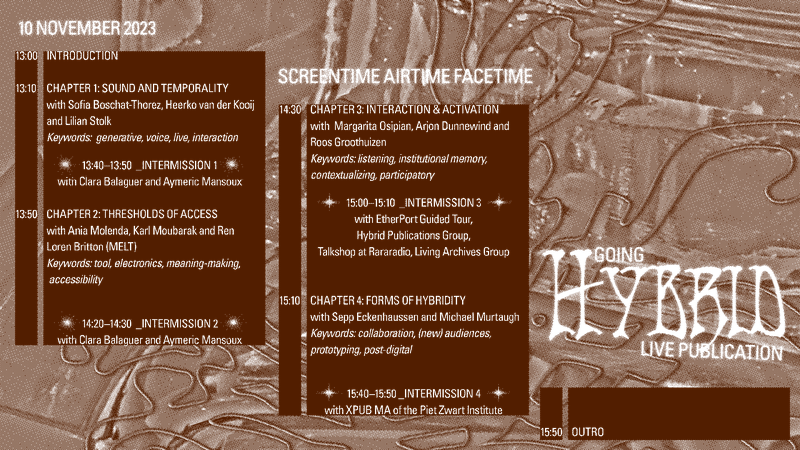
The timetable of the livestream event Screentime Airtime Facetime: A Live-Publication, which was broadcast on 11 December 2023. Design by Frédérique Gagnon.
The core of this publication consists of the conversation-chapters. These live, on-stage conversations put in conversation, quite literally, the working groups that have explored different aspects of hybridity and its outcomes in cultural settings. Chapters as presented in the written variations of this book are direct, lightly edited transcriptions of the spoken conversations. Each chapter features representatives of two research groups, joining in conversation about shared concerns or points of interest. The real outcomes of our research are therefore not entirely straightforward, fully functional ‘solutions’, but the red threads that we found to be essential in creatingmore inclusive, critical and sustainable hybrid culture - across livestreams, publications or archiving.
The first chapter, titled ‘audioSound and Temporality’, connects the Living Archives group with the Participatory Livecasting group. In both these clusters, the concepts of what it means to be present and hybrid across temporalities of past, present and future were key in developing their research and experiments.
‘Thresholds of Access’, the second chapter, reflects on what kind of mediation is necessitated by performancelive events to provide both human and technological access. In this chapter, the Participatory Livecasting group and the Hybrid Publications group joined in conversation.
The speakers in the third chapter, including people from the Living Archives group and IMPAKT, discussed ‘Interaction and Activation’. They question how relations between online and offline audiences and materials are formed, maintained and given space to become meaningful.
The next chapter involves the Hybrid Publications group and the Experimental Publishing masters of Piet Zwart to discuss different ‘Forms of Hybridity’ and what kind of axes, attitudes and approaches to hybridity overlap in their research.
The three final chapters are republished blogposts. These were not created during the live event but preceded it, and were made public on the research blog of Going Hybrid. On this research blog, the process and outcomes of each group are documented. See: https://networkcultures.org/goinghybrid. Each post elaborates on the more theoretical dimensions of one of the research groups (events, publications, archives).
Between the chapters, a series of intermissions is inserted. These contributions were prepared the research groups to give a closer insight into the glitches, awkwardness, and interruptions of hybrid cultural practices. Some function as cautionary tales of hybridity, others introduce new tools or the outcomes of experiments. Each, in its own way, is a reflection on the hands-on work done during the project.
Unfortunately, the space of a single publication – however hybrid and expanded – cannot cover all the work done within to the Going Hybrid project. Providing context and suggestions for further reading, two overviews are included at the end of this publication: a list of all events that took place in the context of Going Hybrid, and a list of all publications put out by affiliated researchers and practitioners.
The linear succession of chapters, intermissions, and appendixes allows you enjoy the content in the same order that it appeared in during the live event. But if you’re feeling more adventurous, you can pay attention to the spacemargins of this publication, which are portals to non-linear reading experiences. In the inner margins (print) or on the right-hand side of the page (digital), you will find the ‘textlive annotations’: a direct reproduction of the chat during the live event, in which a team of reporters has commented on both the contents of the program and their own experiences. Also in the inner margins (print) or on the left-hand side of the page (digital), you will find textmedium-based tags (e.g., ‘still image’, ‘audio’), indicating the kind of media and hybrids discussed. In the digital version, you can click on these tags to discover other paragraphs with the same tag, making Screentime Airtime Facetime navigable by medium as well as by linear progression. In the print version, you’ll find a more traditional index in the back of the book, showing the numbers of each page the tag appears on. Both functionalities are features of the Etherport tool, which was used to create this publication.
Exploring Hybrid Futures Together
The title Screentime Airtime Facetime hints at our shifting relation to technology. The notorious term screentime gestures towards the recent tendency to develop extremely intimate one-on-one relationships with objectour screens. Airtime gives a nod to older forms of hybrids events; the times of families gathering to audiolisten to the radio or videowatch TV. Facetime emphasises the immediate connections we foster with one another through, for instance, videothe use of video calls. With the gradual succession of these terms, we want to think through the public’s relation to technology, to collective bodies and to each other (with technology as a mediator). What can we learn from a history of different hybrid interactions and take with us as seeds for the future?